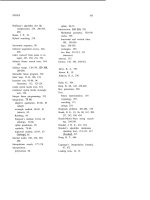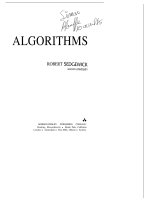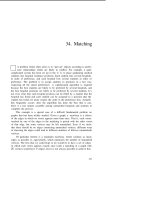Tài liệu Thuật toán Algorithms (Phần 53) docx
Bạn đang xem bản rút gọn của tài liệu. Xem và tải ngay bản đầy đủ của tài liệu tại đây (79.6 KB, 10 trang )
39. Exhaustive Search
Some problems involve searching through a vast number of potential
solutions to find an answer, and simply do not seem to be amenable to
solution by efficient algorithms. In this chapter, we’ll examine some charac-
teristics of problems of this sort and some techniques which have proven to
be useful for solving them.
To begin, we should reorient our thinking somewhat as to exactly what
constitutes an “efficient” algorithm.
For most of the applications that we
have discussed, we have become conditioned to think that an algorithm must
be linear or run in time proportional to something like or to
be considered efficient. We’ve generally considered quadratic algorithms to be
bad and cubic algorithms to be awful. But for the problems that we’ll consider
in this and the next chapter, any computer scientist would be absolutely
delighted to know a cubic algorithm. In fact, even an algorithm would be
pleasing (from a theoretical standpoint) because these problems are believed
to require exponential time.
Suppose that we have an algorithm that takes time proportional to If
we were to have a computer 1000 times faster than the fastest supercomputer
available today, then we could perhaps solve a problem for N = 50 in an
hour’s time under the most generous assumptions about the simplicity of the
algorithm. But in two hour’s time we could only do N = 51, and even in
a year’s time we could only get to N = 59. And even if a new computer
were to be developed with a million times the speed, and we were to have
a million such computers available, we couldn’t get to N = 100 in a year’s
time. Realistically, we have to settle for N on the order of 25 or 30. A “more
efficient” algorithm in this situation may be one that could solve a problem
for N = 100 with a realistic amount of time and money.
The most famous problem of this type is the traveling salesman problem:
given a set of N cities, find the shortest route connecting them all, with no
513
514
39
city visited twice. This problem arises naturally in a number of important ap-
plications, so it has been studied quite extensively. We’ll use it as an example
in this chapter to examine some fundamental techniques. Many advanced
methods have been developed for this problem but it is still unthinkable to
solve an instance of the problem for = 1000.
The traveling salesman problem is difficult because there seems to be no
way to avoid having to check the length of a very large number of possible
tours. To check each and every tour is exhaustive search: first we’ll see how
that is done. Then we’ll see how to modify that procedure to greatly reduce
the number of possibilities checked, by trying to discover incorrect decisions
as early as possible in the decision-making process.
As mentioned above, to solve a large traveling salesman problem is un-
thinkable, even with the very best techniques known. As we’ll see in the next
chapter, the same is true of many other important practical problems. But
what can be done when such problems arise in practice? Some sort of answer is
expected (the traveling salesman has to do something): we can’t simply ignore
the existence of the problem or state that it’s too hard to solve. At the end of
this chapter, we’ll see examples of some methods which have been developed
for coping with practical problems which seem to require exhaustive search.
In the next chapter, we’ll examine in some detail the reasons why no efficient
algorithm is likely to be found for many such problems.
Exhaustive Search in Graphs
If the traveling salesman is restricted to travel only between certain pairs of
cities (for example, if he is traveling by air), then the problem is directly
modeled by a graph: given a weighted (possibly directed) graph, we want to
find the shortest simple cycle that connects all the nodes.
This immediately brings to mind another problem that would seem to
be easier: given an undirected graph, is there any way to connect all the
nodes with a simple cycle? That is, starting at some node, can we “visit” all
the other nodes and return to the original node, visiting every node in the
graph exactly once? This is known as the Hamilton cycle problem. In the
next chapter, we’ll see that it is computationally equivalent to the traveling
salesman problem in a strict technical sense.
In Chapters 30-32 we saw a number of methods for systematically visiting
all the nodes of a graph. For all of the algorithms in those chapters, it was
possible to arrange the computation so that each node is visited just once, and
this leads to very efficient algorithms. For the Hamilton cycle problem, such
a solution is not apparent: it seems to be necessary to visit each node many
times. For the other problems, we were building a tree: when a “dead end”
was reached in the search, we could start it up again, working on another
EXHAUSTIVE SEARCH
515
part of the tree. For this problem, the tree must have a particular structure
(a cycle): if we discover during the search that the tree being built cannot be
a cycle, we have to go back and rebuild part of it.
To illustrate some of the issues involved, we’ll look at the Hamilton cycle
problem and the traveling salesman problem for the example graph from
Chapter 31:
Depth-first search would visit the nodes in this graph in the order A B C E
D F G (assuming an adjacency matrix or sorted adjacency list representation).
This is not a simple cycle: to find a Hamilton cycle we have to try another way
to visit the nodes. It turns out the we can systematically try all possibilities
with a simple modification to the visit procedure, as follows:
procedure integer);
var integer;
begin
:=now;
for to Vdo
if a[k, then
if then visit(t);
end
Rather than leaving every node that it touches marked with a
val entry, this procedure “cleans up after itself” and leaves now and the
array exactly as it found them. The only marked nodes are those for which
visit hasn’t completed, which correspond exactly to a simple path of length
now in the graph, from the initial node to the one currently being visited. To
visit a node, we simply visit all unmarked adjacent nodes (marked ones would
not correspond to a simple path). The recursive procedure checks all simple
paths in the graph which start at the initial node.
516 CHAPTER 39
The following tree shows the order in which paths are checked by the
above procedure for the example graph given above. Each node in the tree
corresponds to a call of visit: thus the descendants of each node are adjacent
nodes which are unmarked at the time of the call. Each path in the tree from
a node to the root corresponds to a simple path in the graph:
Thus, the first path checked is A B C E D F. At this point all vertices adjacent
to F are marked (have non-zero entries), so visit for F unmarks F and
returns. Then visit for D unmarks D and returns. Then visit for E tries F
which tries D, corresponding to the path A B C E F D. Note carefully that
in depth-first search F and D remain marked after they are visited, so that F
would not be visited from E. The “unmarking” of the nodes makes exhaustive
search essentially different from depth-first search, and the reader should be
sure to understand the distinction.
As mentioned above, now is the current length of the path being tried,
and is the position of node k on that path. Thus we can make the visit
procedure given above test for the existence of a Hamilton cycle by having
it test whether there is an edge from k to 1 when In the example
above, there is only one Hamilton cycle, which appears twice in the tree,
traversed in both directions. The program can be made to solve the traveling
salesman problem by keeping track of the length of the current path in the
array, then keeping track of the minimum of the lengths of the Hamilton
SEARCH
517
cycles found.
Backtracking
The time taken by the exhaustive search procedure given above is proportional
to the number of calls to visit, which is the number of nodes in the exhaustive
search tree. For large graphs, this will clearly be very large. For example, if
the graph is complete (every node connected to every other node), then there
are V! simple cycles, one corresponding to each arrangement of the nodes.
(This case is studied in more detail below.) Next we’ll examine techniques to
greatly reduce the number of possibilities tried. All of these techniques involve
adding tests to visit to discover that recursive calls should not be made for
certain nodes. This corresponds to pruning the exhaustive search tree: cutting
certain branches and deleting everything connected to them.
One important pruning technique is to remove symmetries. In the above
example, this is manifested by the fact that we find each cycle twice, traversed
in both directions. In this case, we can ensure that we find each cycle just
once by insisting that three particular nodes appear in a particular order. For
example, if we insist that node C appear after node A but before node B in
the example above, then we don’t have to call visit for node B unless node C
is already on the path. This leads to a drastically smaller tree:
This technique is not always applicable: for example, suppose that we’re trying
to find the minimum-cost path (not cycle) connecting all the vertices. In the
above example, A G E F D B C is a path which connects all the vertices, but









